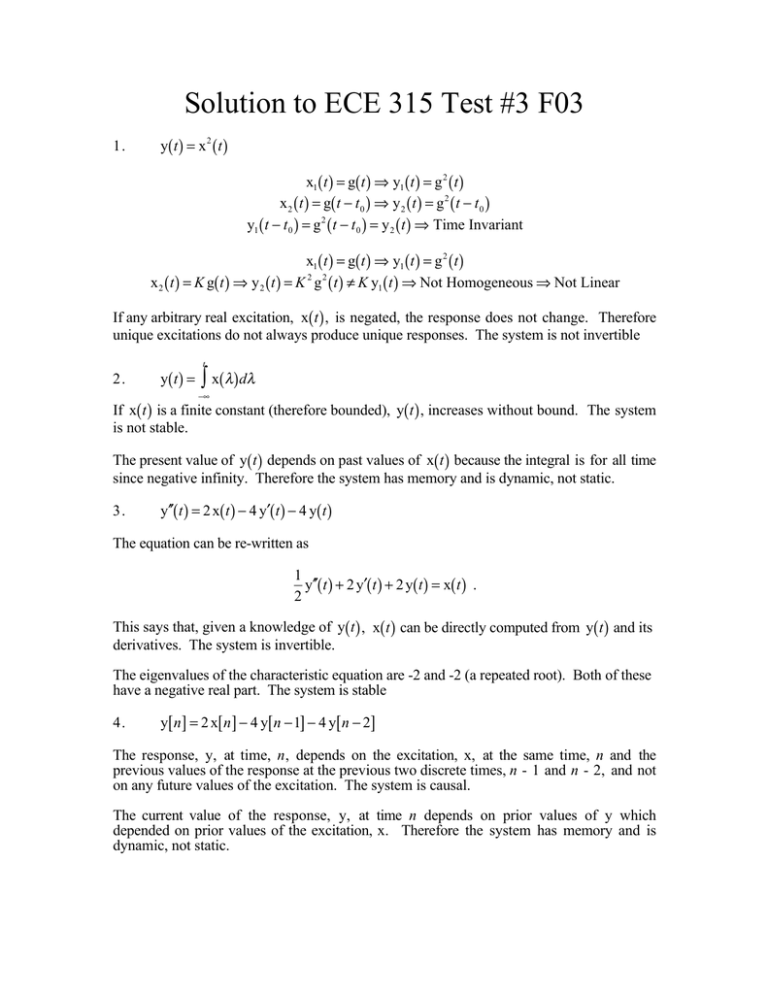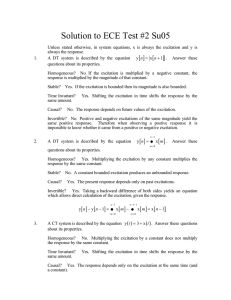Solution to ECE 315 Test #3 F03 ( ) ( )
advertisement

Solution to ECE 315 Test #3 F03 1. y( t ) = x 2 ( t ) x1 ( t ) = g( t ) ⇒ y1 ( t ) = g 2 ( t ) x 2 ( t ) = g( t − t 0 ) ⇒ y 2 ( t ) = g 2 ( t − t 0 ) y1 ( t − t 0 ) = g 2 ( t − t 0 ) = y 2 ( t ) ⇒ Time Invariant x1 ( t ) = g( t ) ⇒ y1 ( t ) = g 2 ( t ) x 2 ( t ) = K g( t ) ⇒ y 2 ( t ) = K 2 g 2 ( t ) ≠ K y1 ( t ) ⇒ Not Homogeneous ⇒ Not Linear If any arbitrary real excitation, x( t ) , is negated, the response does not change. Therefore unique excitations do not always produce unique responses. The system is not invertible 2. y( t ) = t ∫ x(λ)dλ −∞ If x( t ) is a finite constant (therefore bounded), y( t ) , increases without bound. The system is not stable. The present value of y( t ) depends on past values of x( t ) because the integral is for all time since negative infinity. Therefore the system has memory and is dynamic, not static. 3. y′′( t ) = 2 x( t ) − 4 y′( t ) − 4 y( t ) The equation can be re-written as 1 y′′( t ) + 2 y′( t ) + 2 y( t ) = x( t ) . 2 This says that, given a knowledge of y( t ) , x( t ) can be directly computed from y( t ) and its derivatives. The system is invertible. The eigenvalues of the characteristic equation are -2 and -2 (a repeated root). Both of these have a negative real part. The system is stable 4. y[ n ] = 2 x[ n ] − 4 y[ n − 1] − 4 y[ n − 2] The response, y, at time, n, depends on the excitation, x, at the same time, n and the previous values of the response at the previous two discrete times, n - 1 and n - 2, and not on any future values of the excitation. The system is causal. The current value of the response, y, at time n depends on prior values of y which depended on prior values of the excitation, x. Therefore the system has memory and is dynamic, not static. 5. y[ n ] = cos( x[ n ]) x1 [ n ] = g[ n ] ⇒ y1 [ n ] = cos(g[ n ]) x 2 [ n ] = g[ n − n 0 ] ⇒ y 2 [ n ] = cos(g[ n − n 0 ]) y1 [ n − n o ] = cos(g[ n − n o ]) = y 2 [ n ] ⇒ Time Invariant x1 [ n ] = g[ n ] ⇒ y1 [ n ] = cos(g[ n ]) x 2 [ n ] = K g[ n ] ⇒ y 2 [ n ] = cos(K g[ n − n 0 ]) ≠ K cos(g[ n − n 0 ]) ⇒ Not Homogeneous ⇒ Not Linear x[ n ] = cos−1 ( y[ n ]) The inverse cosine function is multiple valued. Therefore the system is not invertible.







